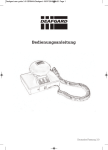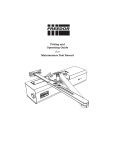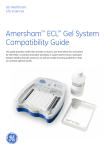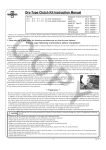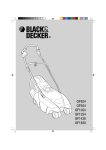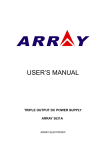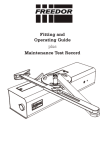Download Deafgard user guide 2.2_Deafgard
Transcript
Operating Guide This is an important document detailing the correct installation and use of the Deafgard. This Guide must be read and fully understood before using the device. This Guide should be kept in a safe place such as your Fire Risk Assessment File. 1 Keep this Guide in a safe place. Contents Introduction Page 3 Important Information Prior to Use 4 The LCD Function 5 Keypad Operation 5 The LEDs - Strobe and Status 6 Batteries 7 Setting the Time 8 Fire Alarm Test 9 Using Deafgard 10 Wake-up Alarm 11 Self Test 12 Sensitivity Adjustment 13 Troubleshooting 14 Manufacturer’s Warranty 15 2 Introduction Deafgard is a Battery operated device designed to alert the deaf and hard of hearing within rooms where the fire alarm is intended to do so. Deafgard triggers into a fire alarm condition when it hears between 1 and 2.4 KHz of continuous sound over 75 Decibels in approximately 20 seconds. The Pillow Pad is designed to be placed under a pillow and will vibrate to wake the user. FIRE will be displayed on the LCD, the Strobe LEDs on the top of the unit will flash and the Pillow Pad will vibrate. The Deafgard unit should be placed next to the bed during use. 3 Important Information Prior to Use Deafgard must only be used for the purpose for which it is designed. It is not suitable for external use. Read this guide and follow the instructions carefully. Keep this Guide in a safe place e.g. in your Fire Risk Assessment File, for future reference. Supplementary information about the sound of a fire alarm: The British Standard for fire alarm installation, BS5839-1: 2002, (Clause 16.2), states: “The sound pressure level of alarm signals should be generally, throughout all accessible areas of the building not less than 65dB(A) . . . where the sound pressure level of background noise is greater than 60dB(A), the sound pressure level of the fire alarm signal should be 5dB above the sound pressure level of the background noise.” It also states:The sound pressure level of alarm signals “should be not less than 75dB(A) at the bed head within rooms in which the fire alarm system is intended to rouse people from sleep.” Deafgard has been designed to the relevant parts of BS 5446-3: Specification for smoke alarm kits for deaf and hard of hearing people. 4 LCD & Keypad The LCD is back-lit and is used to display the Time, Wake-up Alarm settings, low Battery conditions and any faults. In a fire alarm condition, the LCD will display “FIRE”. The LCD will display any error messages such as “PAD”. Keypad Common LCD readouts: FIRE: Fire alarm has sounded PAD: Pillow Pad cable has detatched or has a fault. SELF: Deafgard is conducting a Self Test TEST: Deafgard is conducting a test after Button 4 has been pressed. 1. Button 1 ON/OFF - Power On/Off 2. Button 2 TIME SET - Used to set Time 3. Button 3 INCREMENT - Adjust Clock and Wake-up Alarm settings 4. Button 4 MUTE/SNOOZE - Used to mute Wake-up Alarm as well as testing the Deafgard unit 5. Button 5 ALARM SET - Used to set the Wake-up Alarm 6. Button 6 ALARM ON/OFF - Turns Wake-up Alarm On/Off 5 The LEDs - Strobe and Status The LED lens houses the 3 LEDs - one Status LED in the centre and two Strobe LEDs either side. The Strobe LEDs will flash when in a fire condition or if a major fault has occurred. The Status LED will flash according to the Deafgard status. If Deafgard is turned On, under normal conditions the Status LED will flash green once every 15 seconds. The Status LED will flash red once every 8 seconds if there is a minor fault, such as a Pillow Pad error when the LCD will also display “PAD”. If a major fault occurs the Status LED will flash red once every 4 seconds. This will happen if Deafgard Batteries become critically low. With this fault condition, at 15 second intervals, the Strobe LEDs will flash and the Pillow Pad will vibrate for 4 seconds. The Status LED will illuminate red throughout a fire alarm condition. 6 Batteries - use 4 x C Size LR14 Use Alkaline Only (Do Not Use Rechargeable Batteries) The 4 x C Size Procell Alkaline Batteries supplied should last at least 12 months. Deafgard continually checks the Battery life ensuring safe operation. 1. Open Battery Compartments using a screwdriver. 2. Insert the Batteries into the Battery Compartments (+) positive side facing out. Inserting the Batteries the wrong way could cause damage. 3. When closing the Battery Compartments take care not to over tighten. When “BATT” is displayed on the LCD there are 7 days of Battery life remaining, it is recommended the Batteries are replaced immediately. Note. Deafgard saves all Wake-up Alarm times after Batteries are removed. But ‘real’ time will need to be set. Deafgard does not adjust automatically for Daylight saving time. 7 Setting the Time The Time must be set when the Batteries are removed or replaced. To Set the Time: 1. Press Button 2 TIME SET and hold it down until only the hour numeral is shown on the LCD. Pressing this button again allows you to set the minute. 2. Use Button 3 INCREMENT to adjust the time. Holding down this button increments the numeral in 1/2 second stages. Note. Deafgard operates a 24 hour clock and does not adjust automatically for Daylight saving time. 8 Fire Alarm Test 1. Place Deafgard where it is to be used, i.e. on the bedside table. Place the Pillow Pad under the pillow. 2. Sound the fire alarm for a minimum of 30 seconds. 3. Deafgard activates within 20 seconds, upon hearing the fire alarm. 4. Deafgard will remain in a fire alarm condition until the fire alarm ceases. 5. Should Deafgard not respond to your fire alarm, it may be that your alarm is too quiet. See Sensitivity Adjustment or contact the Technical Advice Line. Note. When Deafgard activates “FIRE” will be displayed on the LCD, the Strobe LEDs on the top of the unit will flash and the Pillow Pad will vibrate. The Deafgard unit should be placed next to the bed during use with the Pillow Pad under the pillow. 9 Using Deafgard 1. To turn the unit On press Button 1 ON/OFF. 2. The LCD will show 00:00 at first power up or if the Batteries have been removed, otherwise the time will be displayed. 3. The Status LED will flash green every 15 seconds to show the unit is working correctly. 4. To turn the unit Off hold Button 1 ON/OFF for 6 seconds, or until the LCD turns Off. Deafgard will not work as a wake-up device and the status LED will no longer flash. Once the unit is in location it is recommended that unit be powered On throughout the day. 10 Wake-up Alarm - Alarm Clock Deafgard can be used as a wake-up Alarm as well as a fire alarm for the deaf and hard of hearing. When the Wake-up Alarm activates the Pillow Pad will vibrate constantly and the LCD will become back-lit. 1. To set the Alarm Clock depress Button 5 ALARM SET and hold it until only the hour numeral is shown on the LCD. Pressing this button again allows you to set the minute. 2. Use Button 3 INCREMENT to adjust the time. Holding down this button increments the numeral in 1/2 second stages. When activated, the Wake-up Alarm can be turned Off by pressing Button 6 ALARM ON/OFF. Once set, the bell symbol will be displayed on the LCD to show the Wake-up Alarm function is set and On. Button 4 MUTE/SNOOZE will snooze the Wake-up Alarm for 8 minutes on first press, 4 minutes on second and 2 minutes on third. To toggle the Alarm Clock On and Off press Button 6 ALARM ON/OFF. Note. The Strobe LEDs flash only when the fire message is received. 11 Self Test Deafgard performs a Self Test on Battery insertion and every 7 days after that. During the Self Test, Deafgard will check its hardware and the LCD will read “SELF”. Should Deafgard detect an internal fault it will sound a warning tone, vibrate its Pillow Pad, the Status LED will flash red and the LCD will display the error. To perform a quick test of the Deafgard hardware hold Button 4 MUTE/SNOOZE until the LCD displays “TEST”. The unit will flash its Strobe LEDs, vibrate its Pillow Pad. Note. The Pillow Pad will not vibrate if placed in the Cradle. 12 Sensitivity Adjustment On identifying a necessary adjustment, use a narrow electrical flat-headed screwdriver. Take care not to over-adjust as this will render the unit inoperative. Sensitivity Adjustment if Deafgard is not sensitive enough, i.e. does not respond to the fire alarm: Note. Deafgard is factory set to be triggered into a fire alarm condition at 75dB(A), as recommended by BS 5839-1:2002. Only adjust sensitivity as a last resort. 1. Carefully insert screwdriver into hole on back of the unit. 2. Turn clockwise through no more than 5 degrees (a small adjustment is equivalent to a large alteration in sensitivity). 3. Test Deafgard to the fire alarm. 4. If problems persist, repeat steps 1-3. Note. The Adjustment Screw is limited in both directions, once you can feel resistance against turning stop to avoid damaging the unit. If Deafgard is too sensitive (responds to no apparent sound) follow steps 1-4, but turn anti-clockwise in Step 2. 13 Troubleshooting The following are the most frequently asked questions regarding the Deafgard unit, with a quick checklist to follow: 1. Why does Deafgard not react to your fire alarm? • Check fire alarm is louder than 75dB. • Check Batteries. • Check fire alarm is sounding for at least 30 seconds. • Adjust sensitivity of the Deafgard unit. 2. Why does the Pillow Pad not vibrate? • Check Power is On. • Check Batteries. • Check cable from Pillow Pad is connected securely to the Deafgard unit. • Check Pillow Pad is not in the cradle. Note. Deafgard will display error messages on the LCD if a fault occurs. If this happens perform a reset on the unit by removing and re-insert all Batteries. If error remains contact the Technical Advice Line. 3. Why do Strobe LEDs not flash? • Check Power is On. • Check Batteries. • Check cable from Pillow Pad is connected securely to the Deafgard unit. 4. Why is there no display on the LCD? • Check Power is On. • Check Batteries. If all the above points are satisfied and further assistance is required please contact the Technical Advice Line. 14 Manufacturer’s Warranty Fireco Limited (“we” and “us”) warrants to the customer (“you” and “your”) that the product will be free from defects in material and workmanship for a period of 24 months from the date of purchase. If the product is defective whilst under warranty we will, at our option, repair the product or replace it free of charge. If the product appears to develop a defect while under warranty please first check that the product is being correctly used in accordance with this Operating Guide and that the Batteries are functioning. If this does not resolve the problem please contact us in writing at the e-mail address shown below or telephone the Technical Advice Line. The warranty does not apply to any defect in the product arising from fair wear and tear, wilful damage, accident, negligence by you or any third party, abnormal working conditions failure to follow the instructions in this Guide, misuse or alteration or repair of the product without our prior approval. The warranty does not cover Batteries, which may need to be replaced within the period of the warranty. We will not be liable to you for any loss of profits, administrative inconvenience or indirect or consequential loss or damage arising out of any defect in the product. Where the products are sold under a consumer transaction (as defined by the Consumer Transactions (Restrictions on Statements) Order 1976) your statutory rights are not affected by the terms of this warranty. Version 2.2 For Technical Assistance contact the UK Technical Advice Line on: 0845 241 75 75 (Local Rate) or +44 (0) 1273 320 688 e-mail us at [email protected] www.deafgard.com For all other quries please contact your supplier.
















